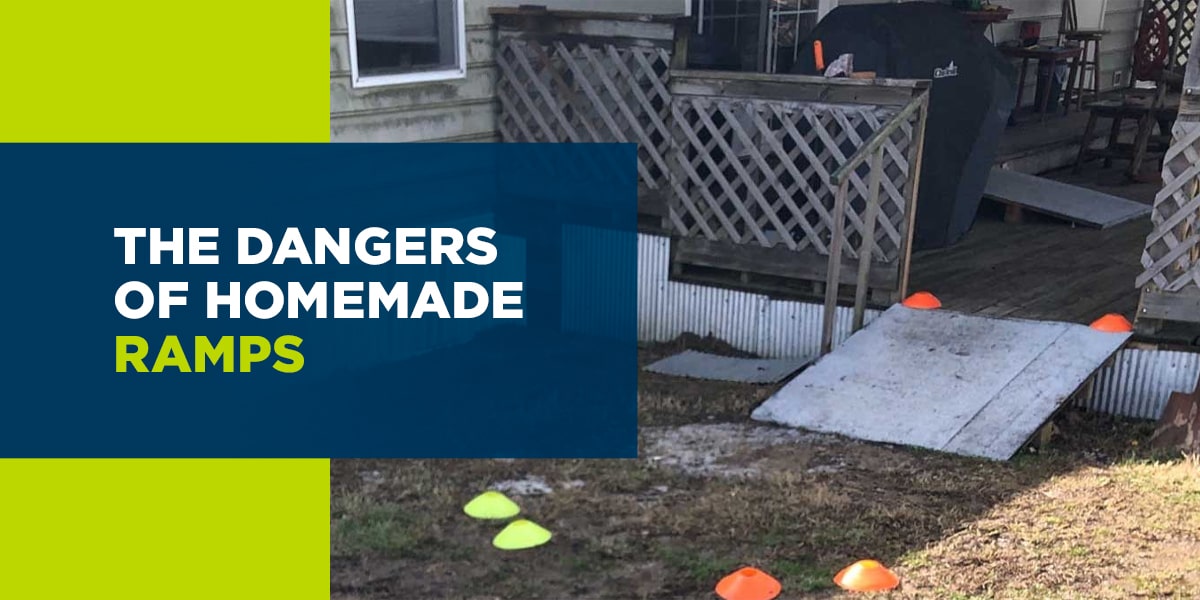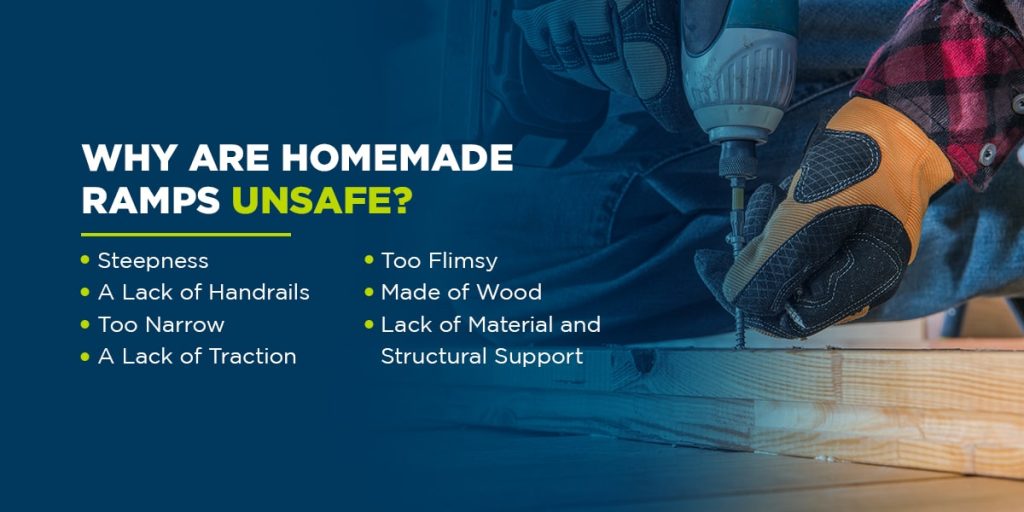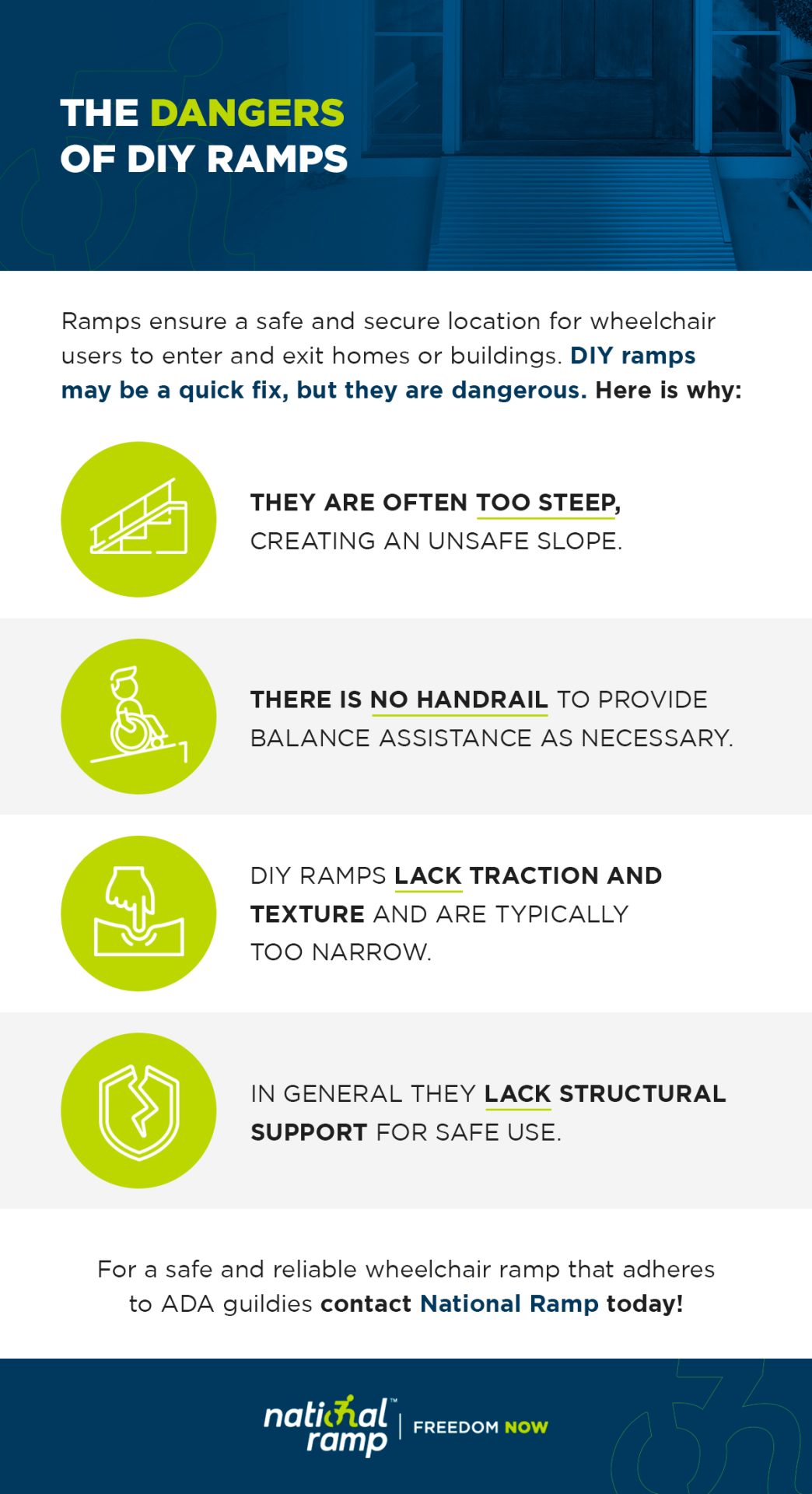
As ramp manufacturers, we see many well-intentioned attempts to create an acceptable wheelchair ramp. One common problem is the slope height, which poses a hazard for someone with mobility difficulties to reasonably bypass the stairs outside their home. When the caretakers of disabled friends and relatives realize how impractical and even outright dangerous these homemade wheelchair ramps are, they often hire professionals.
Whether a family member, local organization, Scout or other community member built the wheelchair ramp, if critical safety elements are missing, it will lack the support to provide safe access to and from the home. Keep reading to learn more about what makes bad wheelchair ramps a problem for people with disabilities.
In This Article

Why Are Homemade Ramps Unsafe?
At first glance, a ramp appears to be a relatively simple structure. Many caretakers decide setting up a DIY ramp for stairs is feasible because it looks easy to build. This approach ignores all the most beneficial features of a well-made ramp, like its ability to meet Americans with Disability Act standards and its overall durability.
Below are problems homemade ramps often have.

1. Steepness
Though you can install a private, residential ramp that fails to comply with the rule of one foot of length per inch of elevation or other ADA guidelines, you still have to ensure it’s safe. Resting a board over a steep staircase creates a slide effect that can result in slips and falls. If the ramp is steeper than the ADA requirement, you will have to expend more effort to climb it, and going down could create unsafe momentum.
Even power wheelchair users should only travel over slopes that fit the manufacturer’s guidelines. This safety element is crucial for residential ramps, but many people don’t know how to create the required angles for a wheelchair-safe slope. Short homemade ramps are often the most dangerous, but caretakers build them believing they will be easy to use, since they take up little space.
When learning how to build a ramp over stairs, you must consider their pitch. A ramp should have a slope of at least 1-in-12 for maximum safety. Since cutting corners with a makeshift ramp can create more problems than it solves, custom ramps built for a specific staircase are the best products.
2. A Lack of Handrails
Some caretakers attempt to place a set of boards or a single sheet of wood as a temporary ramp over stairs without considering the risks. Creating a handrail from scratch is time-consuming and challenging, so you might think you can skip it entirely. Placing a piece of wood over a set of stairs without side rails is unacceptable, even if you are there to help your loved one go up or down.
Handrails provide balance assistance when a fall hazard is present. According to the ADA, your ramp should have banisters if the elevation is above six inches. Though the ADA guidelines only govern public properties, your residential ramp should still have handrails for safety if the staircase lacks them.
Some weather conditions can make a ramp without handrails even more dangerous to use. In cold weather or slick conditions, people who use the ramp have nothing to grab onto if they slip. Even a light dusting of snow can pose a risk. Any ramp longer than six feet should have a handrail, even if you are building yours for private use.
3. Too Narrow
A narrow ramp is inappropriate for many mobility devices, especially if they might hang off the edges. Narrow ramps are challenging to use in general, but when you’re trying to help move a wheelchair, you could injure your hands from trying to prevent your loved one from falling, and even if the ramp is barely wide enough for the wheelchair, you will probably scrape the wheels against the sides.
According to the ADA guidelines, you should have at least 36 inches of clearance between the ramp and handrails. A manual wheelchair is usually about 25 inches wide. If the ramp is less than 36 inches wide, it will be challenging for even a skilled wheelchair user to get around without help.
4. A Lack of Traction
Many homemade ramps lack enough traction for people with mobility devices to safely use them, usually because of the materials used to build the ramp. For example, a plywood surface for an accessibility ramp is a poor choice. Plywood also provides little structural support and can get slick when wet. Some people use grip tape on their plywood ramps to add a degree of traction, but even this extra step makes for a poor ramp.
Many homemade ramps lack the texture to generate traction. Wheelchair ramps constructed of decking require adequate spacing between planks to provide some slip resistance.
5. Too Flimsy
Many homemade bridges consist of whatever materials people can access cheaply and quickly. A thin, flimsy bridge can easily shatter or break during use, leading to accidents and injuries. It’s possible to build a bridge that appears stable but fails to hold up under the weight of a wheelchair user.
Even if you attempt to build your bridge using quality materials, you won’t know its weight capacity. Professionally made bridges undergo tests to pinpoint a preferable range and limit for the weight capacity. If you build a DIY bridge, you must guess its weight capacity and hope it stays in one piece.
6. Made of Wood
Homemade wooden wheelchair ramps are usually different from professionally constructed wood accessibility ramps. Most people who make a ramp from wood place it over stairs, ignoring the need for traction. They might also use inexpensive materials to save money.
Unlike a steel or concrete ramp, wood eventually rots, especially outdoors, where it is subject to extreme weather. Wood absorbs moisture and gets slippery when wet. It does not hold up well without diligent maintenance. All wood ramps should have a slip-resistant coating to provide the most traction possible. People might be unaware of how to maintain the ramp after building it, which is why it can become slippery or cave in with repeated use.
7. Lack of Material and Structural Support
You might feel comfortable with woodworking and other DIY projects. Still, even if you have expert carpentry skills, it’s best to trust experienced professionals to manufacture and install a disability ramp if you’ve never built one before. It’s crucial to use the appropriate materials and design the ramp with sufficient support.
One problem that affects homemade ramps’ structural support is the leg construction. DIYers rarely know how to space the legs correctly, which can lead to sagging as the ramp ages. Another issue is the use of low-quality materials that will easily fall apart or deteriorate.
Many people who build a DIY ramp are short on time and want an accessible way to enter and exit their residence as quickly as possible. A professionally installed ramp is the safest option available, and National Ramp can efficiently complete your installation process.

Order a Quality Wheelchair Ramp With National Ramp
Do you want to order a reliable wheelchair ramp that lacks the above problems? We make our durable products to adhere to ADA guidelines. Contact us to learn more about our products or browse for a ramp that fits your needs.

Don’t Risk Injury To You Or A Loved One
Why wait? Give us a call at 877-596-7293 or contact us online to get started!